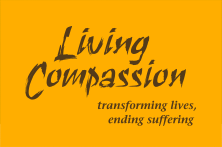Recently I’ve been enjoying realizing how perfectly meditation practice teaches us the how of letting go and letting life live us.
As we know, the only thing standing between a “me” and a peaceful, joyful life is egocentric karmic conditioning’s “better ideas” about how life should be. Those interfering better ideas are difficult to recognize, harder still to let go, when we’re busily going about the day. But when we sit in meditation we can practice being open to everything that is, just as it is, in a safe, “manageable” environment.
For instance, a thought--the result of a sensation labeled anxiety--arises about something I need to do. If I’m up and moving around in life, that combination of thought and emotion can launch a flurry of unconscious activity leading to more unnoticed sensations, thoughts, emotions, behaviors—and suffering. But here I am sitting in meditation. I can watch the whole thing arise, linger, and pass through, knowing I’m not going to follow any conditioned patterns of behavior because my commitment is to staying here paying close attention for this period of practice.
There’s a sensation somewhere in the body that carries the label “pain.” I get to practice being with those sensations rather than allowing conditioned mind to take the label and run with it—run away from the sensations and the body having them. I can stay with the body, exploring what feeling feels like when labels and stories don’t get to replace experience.
Practicing in this way lets me see the process egocentric karmic conditioning/self-hate employs to take the life force away from life and to use that energy for its own suffering purposes. I get to see how I have been conditioned to abandon myself each time a story arises that “this is too hard” or “I don’t like this” or “I don’t want to do this” or “this is scary.” Sitting there, present, alert, attentive, willing, committed, I can recognize that’s not “me” talking about “too hard/don’t want to.” That which has made this commitment to meditate, to wake up, wants me to live without suffering, knows stillness as home, is life and revels in the delight of being present with itself. And I get to see that THAT is all of me.
As the awareness of what is animating a human being becomes more obvious, the enthusiasm for following an illusion of a separate self around through life dwindles rapidly. Shall I choose to have my life guided by unconditional love or a cruel and hateful conversation? Doesn’t require a lot of discernment.
Faith and trust grow with practice. We can relax into life’s utterly impersonal unconditional love. We can feel the stress of trying to figure it out, trying to get it right, of believing we should know or that there’s something to know or someone to know it drain from our body, mind, and emotions. As we learn simply to be in meditation, we know how simply to be in life…and that is worth practicing!
In gassho,
Cheri
